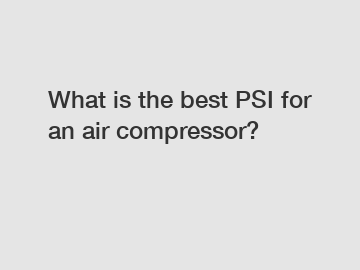What is the best PSI for an air compressor?
When it comes to operating an air compressor effectively, one crucial aspect to consider is the right PSI (Pounds per Square Inch) setting. PSI determines the pressure at which your air compressor delivers airflow, making it a key factor in achieving optimal performance. This blog post aims to provide you with comprehensive insights, guidance, and practical tips to guide you in ascertaining the best PSI for your air compressor. Let's delve into the world of air pressure!
Understanding PSI:
PSI is commonly used as a unit of measurement for air pressure. Whether you're a seasoned professional or an eager DIY enthusiast, it's vital to understand that the PSI requirements can vary based on your specific task or application. Using the correct PSI translates to efficient and satisfactory performance, while deviating from the optimal setting can lead to underwhelming outcomes or even damage your equipment.

Factors to Consider:
1. Application: Different tasks demand different PSI settings. For instance, if you're painting, a higher PSI will help you achieve a smoother finish, while pneumatic nailers or staplers typically require lower PSI settings. Prioritize understanding the PSI recommendations for your intended applications to ensure desired results.
2. Equipment Compatibility: Manufacturers generally specify the recommended PSI range for their air tools and equipment. Using PSI settings outside this range may result in equipment malfunction or premature wear and tear. Always refer to your tools' user manuals or consult the manufacturer's guidelines for PSI requirements.
3. Pressure Drop: Overcoming the natural pressure drop during transportation through hoses and fittings is vital. A pressure drop can occur due to long hoses, restrictive fittings, or inadequate airflow. To compensate for pressure loss, consider setting your air compressor to a slightly higher PSI than your intended usage demand.
4. Safety Considerations: Striking a balance between achieving desired results and maintaining safety is essential. Excessively high PSI can pose a threat by damaging equipment, causing leaks, or even leading to accidents. Always prioritize safety and use the highest pressure necessary, not the highest pressure possible.
Determining the Ideal PSI:
To ascertain the ideal PSI setting for your air compressor, follow these steps:
1. Assess Your Tools' Requirements: Identify the recommended PSI range for your air tools. Note down the upper and lower limits specified by the manufacturer. Keep in mind that different tools might have distinct PSI requirements.
2. Gauge Your Needs: Analyze the typical tasks you undertake or plan to perform with your air compressor. Consider your personal preferences, desired performance, and the materials you will be working with. Some experimentation may be necessary to find the ideal PSI for your specific application.
3. Start with an Average PSI: As a general rule of thumb, setting your compressor to around 90 PSI is a safe starting point for most applications. From there, you can incrementally increase or decrease the pressure based on your observations and requirements.
4. Test and Observe: Deploy your air compressor at the chosen PSI, connect the appropriate tool, and conduct a trial run. Evaluate the airflow, tool performance, and the quality of results. Keep in mind that this process may require adjustments and fine-tuning to reach an optimal PSI for your equipment and tasks.
The Benefits of Finding the Sweet Spot:
Discovering the ideal PSI for your air compressor offers several advantages:
1. Enhanced Efficiency: Operating your air tools at the optimal PSI setting ensures they perform at their best, resulting in improved efficiency and productivity. You'll be able to complete tasks more effectively, saving both time and effort.
2. Extended Equipment Lifespan: Employing the correct PSI safeguards your tools and equipment from excessive strain or damage. Preventing unnecessary wear and tear can extend their lifespan, reducing costs associated with repairs or replacements.
3. Improved Safety: Operating within recommended PSI limits ensures a safer working environment. Minimizing the risk of equipment failures or accidents protects you, your colleagues, and your workspace.
Conclusion:
Selecting the perfect PSI for your air compressor is a vital component of achieving exceptional performance, efficiency, and longevity. By considering your specific applications, equipment compatibility, safety measures, and testing methods, you can pinpoint the optimal PSI setting that suits your needs precisely. Remember, finding the ideal PSI is an ongoing process, as diverse tasks and tools may require adjustments. The key is to prioritize safety, efficiency, and achieving the best results. Happy air compressing!
Contact us to discuss your requirements of china gx pcp compressor supplier, 4500psi stirrup pump for emergency, pcp air compressor company. Our experienced sales team can help you identify the options that best suit your needs.


